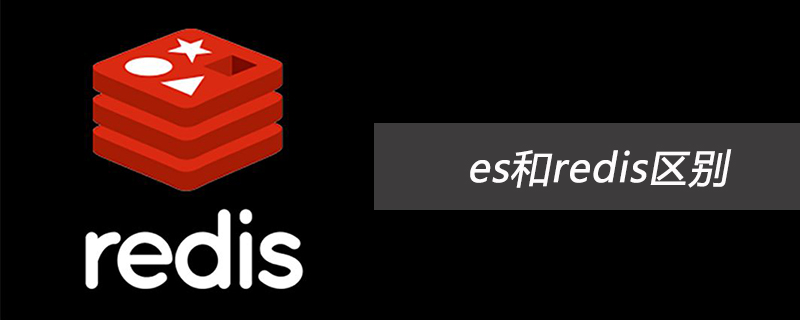 Database
Database Redis
Redis Sharing of high-frequency Redis interview questions will help you master core knowledge points!
Sharing of high-frequency Redis interview questions will help you master core knowledge points!This article will sort out and share some high-frequency Redis interview questions with you, and take you through the core knowledge points of Redis, involving data structure, memory model, IO model, persistent RDB, etc. I hope it will be helpful to you!

Why is Redis so fast?
Many people only know that it is a K/V NoSQl in-memory database, single thread... This is because they do not fully understand Redis and cannot continue to ask more questions.
This question is a basic understanding. We can implement it from the underlying data structures of different data types in Redis, completely based on memory, IO multiplexing network model, thread model, progressive rehash...
How fast?
We can first talk about how fast it is. According to official data, Redis's QPS can reach about 100,000 (requests per second). Those who are interested can refer to the official benchmark program "How fast is Redis?" 》, address: redis.io/topics/benc…

The horizontal axis is the number of connections, and the vertical axis is QPS.
This picture reflects an order of magnitude. Through quantification, it makes the interviewer feel that you have read the official documents and are very rigorous.
Memory-based implementation
Redis is a memory-based database. Compared with disk databases, it completely beats the speed of disks.
Both read and write operations are completed in memory. Let's compare the differences between memory operations and disk operations respectively.
Disk call

Memory operation
Memory is directly controlled by the CPU, also It is the memory controller integrated inside the CPU, so the memory is directly connected to the CPU and enjoys the optimal bandwidth for communication with the CPU.
Finally, a picture is used to quantify the various delay times of the system (part of the data is quoted from Brendan Gregg)

Efficient data structure
When I was learning MySQL, I knew that the B Tree data structure was used in order to improve the retrieval speed, so the fast speed of Redis should also be related to the data structure.
Redis has a total of 5 data types, String, List, Hash, Set, SortedSet.
Different data types are supported by one or more data structures at the bottom, in order to pursue faster speed.
Brother Ma’s message: We can explain the advantages of the underlying data structure of each data type separately. Many people only know the data type, and telling the underlying data structure can make people’s eyes shine.

SDS simple dynamic string advantage

SDS in len save this The length of the string, O(1) time complexity to query the string length information.
Space pre-allocation: After SDS is modified, the program will not only allocate the necessary space required for SDS, but also allocate additional unused space.
Lazy space release: When shortening the SDS, the program will not reclaim the excess memory space, but use the free field to record the number of bytes and not release them later. If an append operation is required, the unused space in free is used directly, reducing memory allocation.
zipList Compressed List
Compressed list is one of the underlying implementations of the three data types: List, hash, and sorted Set.
When a list has only a small amount of data, and each list item is either a small integer value or a relatively short string, then Redis will use a compressed list as the underlying implementation of the list key.

This way the memory is compact and saves memory.
quicklist
Subsequent versions have transformed the list data structure, using quicklist instead of ziplist and linkedlist.
Quicklist is a mixture of ziplist and linkedlist. It divides linkedlist into segments. Each segment uses ziplist for compact storage, and multiple ziplists are connected in series using bidirectional pointers.

skipList Skip List
The sorting function of sorted set type is implemented through the "skip list" data structure.
The skip list (skiplist) is an ordered data structure that maintains multiple pointers to other nodes in each node to achieve the purpose of quickly accessing nodes.
The skip list adds multi-level indexes on the basis of the linked list, and realizes rapid positioning of data through several jumps in the index position, as shown in the following figure:

Integer array (intset)
When a set only contains integer value elements, and the number of elements in this set is not large, Redis will use an integer set as the underlying implementation of the set key to save memory.
Single-threaded model
Code Brother’s message: We need to note that the single-thread of Redis refers to the network IO of Redis (network IO after version 6.x Using multi-threading) and key-value pair instruction reading and writing are executed by one thread. For Redis persistence, cluster data synchronization, asynchronous deletion, etc., they are all executed by other threads.
Don’t say that Redis has only one thread.
Single thread refers to the execution of Redis key-value pair read and write instructions in a single thread.
Let me talk about the official answer first, which makes people feel rigorous enough, instead of just reciting some blogs based on what others say.
Official answer: Because Redis is a memory-based operation, the CPU is not the bottleneck of Redis. The bottleneck of Redis is most likely to be the size of the machine memory or the network bandwidth. Since single-threading is easy to implement and the CPU will not become a bottleneck, it is logical to adopt a single-threaded solution. Original address: redis.io/topics/faq.
Why not use multi-threaded execution to fully utilize the CPU?Before running each task, the CPU needs to know where the task is loaded and started running. That is, the system needs help setting up the CPU registers and program counter beforehand, which is called the CPU context.
When switching contexts, we need to complete a series of work, which is a very resource-consuming operation.
Introducing multi-threaded development requires the use of synchronization primitives to protect concurrent reading and writing of shared resources, increasing code complexity and debugging difficulty.What are the benefits of single thread?
- There will be no performance consumption caused by thread creation;
- Avoid CPU consumption caused by context switching, and there is no overhead of multi-thread switching;
- Avoid It eliminates competition issues between threads, such as adding locks, releasing locks, deadlocks, etc., and there is no need to consider various lock issues.
- The code is clearer and the processing logic is simple.


typedef struct redisObject{
//类型
unsigned type:4;
//编码
unsigned encoding:4;
//指向底层数据结构的指针
void *ptr;
//...
}robj;Hash conflict what to do? Redis resolves conflicts through chained hashing: That is, the elements in the same bucket are saved using a linked list. However, when the linked list is too long, the search performance may deteriorate. Therefore, in order to pursue speed, Redis uses two global hash tables. Used for rehash operations to increase the number of existing hash buckets and reduce hash conflicts.
Start by default using "hash table 1" to save key-value pair data, and "hash table 2" has no allocated space at this time. When more and more data triggers the rehash operation, the following operations are performed:- Allocate more space to "hash table 2";
- Remap and copy the data of "hash table 1" to "hash table 2";
- Release The space of hash table 1.
It is worth noting that the process of remapping the data from hash table 1 to hash table 2 is not a one-time process. This will cause Redis to block and be unable to provide services.
Instead, progressive rehash is used. Each time a client request is processed, it starts from the first index in "hash table 1" and rehash this position. All data is copied to "hash table 2", and the rehash is dispersed into multiple requests to avoid time-consuming blocking.
How does Redis achieve persistence? How to recover data after a crash?
Redis’ data persistence uses the “RDB data snapshot” method to achieve rapid recovery from downtime. However, executing full data snapshots too frequently has two serious performance overheads:
- Frequently generate RDB files and write them to disk, which causes excessive disk pressure. It will appear that the previous RDB has not been executed yet, and the next one starts to be generated again, falling into an infinite loop.
- Fork out of the bgsave sub-process will block the main thread. The larger the memory of the main thread, the longer the blocking time.
So Redis also designed the AOF post-write log to record the instructions for modifying the memory.
Interviewer: What is RDB memory snapshot?
When Redis executes the "write" command, the memory data will continue to change. The so-called memory snapshot refers to the status data of the data in Redis memory at a certain moment.
It’s like time is frozen at a certain moment. When we take pictures, we can completely record the moment of a certain moment through photos.
Redis is similar to this, which is to capture the data at a certain moment in the form of a file and write it to the disk. This snapshot file is called RDB file. RDB is the abbreviation of Redis DataBase.

#When doing data recovery, directly read the RDB file into the memory to complete the recovery.
Interviewer: During the generation of RDB, can Redis handle write requests at the same time?
Yes, Redis uses the operating system's multi-process copy-on-write technology COW (Copy On Write) to achieve snapshot persistence and ensure data consistency.
Redis will call the glibc function during persistence fork to generate a child process. Snapshot persistence is completely handled by the child process, and the parent process continues to process client requests.
When the main thread executes the write command to modify the data, the data will be copied. bgsave The child process reads the copy data and writes it to the RDB file.
This not only ensures the integrity of the snapshot, but also allows the main thread to modify the data at the same time, avoiding the impact on normal business.

Interviewer: So what is AOF?
The AOF log records all the modified instruction sequences since the creation of the Redis instance. Then it can be restored by executing all instructions sequentially on an empty Redis instance, that is, "replaying". The state of the memory data structure of the current instance of Redis.
AOF configuration items provided by RedisappendfsyncThe writeback strategy directly determines the efficiency and security of the AOF persistence function.
-
always: Synchronous write back, the content in the
aof_bufbuffer will be written to the AOF file immediately after the write command is executed. - everysec: Write back every second. After the write command is executed, the log will only be written to the AOF file buffer, and the buffer content will be synchronized to the disk every second.
- no: Under the control of the operating system, after the write execution is completed, the log is written to the AOF file memory buffer, and the operating system decides when to flush it to the disk.
There is no best-of-both-worlds strategy, we need to make a trade-off between performance and reliability.
Interviewer: Since RDB has two performance problems, why not use AOF.
AOF pre-write log records each "write" command operation. It will not cause performance loss like RDB full snapshot, but the execution speed is not as fast as RDB. At the same time, too large log files will also cause performance problems.
So, Redis has designed a killer "AOF rewriting mechanism". Redis provides the bgrewriteaof instruction to slim down the AOF log.
The principle is to open a sub-process to traverse the memory and convert it into a series of Redis operation instructions, which are serialized into a new AOF log file. After the serialization is completed, the incremental AOF log that occurred during the operation is appended to the new AOF log file. After the appending is completed, the old AOF log file is immediately replaced, and the slimming work is completed.

#Interviewer: How to achieve as little data loss as possible while taking into account performance?
When restarting Redis, we rarely use rdb to restore the memory state because a large amount of data will be lost. We usually use AOF log replay, but the performance of AOF log replay is much slower than RDB, so when the Redis instance is large, it takes a long time to start.
In order to solve this problem, Redis 4.0 brings a new persistence option-Hybrid persistence. Store the contents of the rdb file together with the incremental AOF log file. The AOF log here is no longer the full log, but the incremental AOF log that occurred during the period from the beginning of persistence to the end of persistence. Usually this part of the AOF log is very small.
SoWhen Redis restarts, you can load the rdb content first, and then replay the incremental AOF log, which can completely replace the previous AOF full file replay, and the restart efficiency is greatly improved.
Redis master-slave architecture data synchronizationRedis provides a master-slave mode, which copies a redundant copy of data to other Redis servers through master-slave replication.Interviewer: How to ensure data consistency between master and slave?In order to ensure the consistency of the replica data, the master-slave architecture adopts a read-write separation method.
- Read operation: both the master and slave libraries can execute;
- Write operation: the master library executes it first, and then synchronizes the write operation to the slave library;

Interviewer: Does master-slave replication have other functions?
- Failure recovery: When the master node goes down, other nodes can still provide services;
- Load balancing: The Master node provides write services, and the Slave node provides read services to share the pressure ;
- High availability cornerstone: It is the basis for the implementation of Sentinel and cluster, and the cornerstone of high availability.
Interviewer: How is master-slave replication implemented?Synchronization is divided into three situations:
- The first full copy of the master-slave library;
- Synchronization during the normal operation of the master-slave;
- The network between the master and slave libraries is disconnected and reconnected for synchronization.
Interviewer: How to achieve the first synchronization?
The first replication process of the master-slave database can be roughly divided into three phases: the connection establishment phase (ie, the preparation phase), the phase of synchronizing data from the master database to the slave database, and the phase of sending new data during synchronization. Write commands to the slave library stage;

- Establish a connection:
- The slave library will establish a connection with the main library, execute replicaof from the library and send psync Command and tell the main library that synchronization is about to take place. After the main library confirms the reply, synchronization between the master and slave libraries will begin. The master library synchronizes data to the slave library: the master executes the
- bgsave
command to generate an RDB file and sends the file to the slave library. At the same time, themain library opens up for each slave A replication buffer buffer records all write commands received since the RDB file was generated. Save the RDB from the library, clear the database, and then load the RDB data into memory. Send the new write command received after RDB to the slave library: the write operation after generating the RDB file is not recorded in the RDB file just now. In order to ensure the consistency of the master-slave library data, the master library A replication buffer will be used in memory to record all write operations after the RDB file is generated. And send the data inside to slave.
Interviewer: What should I do if the network between the master and slave databases is disconnected? Do I need to copy the full volume again after disconnecting?Before Redis 2.8, if the master-slave library experienced a network interruption during command propagation, the slave library would perform a full copy with the master library again, which was very expensive. Starting from Redis 2.8, after the network is disconnected, the master-slave library will use incremental replication to continue synchronization. Incremental replication:
Used for replication after network interruption and other situations. Only the write commands executed by the master node during the interruption are sent to the slave node, which is more efficient than full replication.
The secret of disconnecting and reconnecting incremental replication is therepl_backlog_buffer buffer. No matter when, the master will record the write instruction operation in repl_backlog_buffer, because the memory Limited, repl_backlog_buffer is a fixed-length circular array, if the array content is full, it will overwrite the previous content from the beginning.
master_repl_offset to record the position offset written by itself, and slave uses slave_repl_offset to record the offset that has been read.

runID, slave_repl_offsetSend to master.
master_repl_offset and slave_repl_offset to the slave library.
The incremental copy execution process is as follows:

Interviewer: After completing full synchronization, how to synchronize data during normal operation?
When the master-slave library completes full replication, a network connection will be maintained between them. The master library will use this connection to synchronize subsequent command operations received successively to the slave library. This process Also known as command propagation based on long connections, the purpose of using long connections is to avoid the overhead caused by frequent connection establishment.
Sentinel Principle Q&A
Interviewer: Sure, I know so much, do you know the Sentinel Cluster Principle?
Sentinel is an operating mode of Redis. It focuses on monitoring the running status of Redis instances (master nodes, slave nodes), and can pass a series of actions when the master node fails. The mechanism realizes master selection and master-slave switching, realizes failover, and ensures the availability of the entire Redis system.
His architecture diagram is as follows:

#Redis Sentinel has the following capabilities:
- Monitoring : Continuously monitor whether the master and slave are in expected working status.
- Automatically switch the master database: When the Master fails, Sentinel starts the automatic failure recovery process: select one of the slaves as the new master.
- Notification: Let the slave execute replicaof to synchronize with the new master; and notify the client to establish a connection with the new master.
Interviewer: How do the sentinels know each other?
The sentinel establishes communication with the master and uses the publish/subscribe mechanism provided by the master to publish its own information, such as height and weight, whether single, IP, port...
master has a## Dedicated channel of #__sentinel__:hello, used for publishing and subscribing messages between sentinels. This is like __sentinel__:hello WeChat group. Sentinels use the WeChat group established by master to publish their own messages, and at the same time pay attention to the messages released by other sentinels.
Interviewer: Although the sentinels have established a connection with each other, they still need to establish a connection with the slave. Otherwise, they cannot be monitored. How do you know the slave and monitor them?The key is to use the master to achieve it. The sentinel sends the
INFO command to the master. The master naturally knows all the slaves under his sect. So after the master receives the command, it tells the sentinel the slave list.

Interviewer: In addition to sentries, are there any other high-availability methods?There is a Cluster cluster to achieve high availability. The Redis cluster monitored by the Sentinel cluster has a master-slave architecture and cannot be easily expanded.
Using Redis Cluster cluster mainly solves various slow problems caused by large data storage, and also facilitates horizontal expansion.
When facing millions or tens of millions of users, horizontally scalable Redis slicing clusters will be a very good choice.
Interviewer: What is a Cluster?Redis cluster is a distributed database solution. The cluster manages data through sharding (a practice of "divide and conquer") and provides replication and failover functions. Divide the data into 16384 slots, and each node is responsible for a part of the slots. Slot information is stored in each node. It is decentralized. As shown in the figure, the cluster consists of three Redis nodes. Each node is responsible for a part of the data of the entire cluster. The amount of data that each node is responsible for may be different.

Gossip protocol, and finally each node saves Depends on the allocation of slots to other nodes.
Interviewer: How are hash slots mapped to Redis instances?
- According to the key of the key-value pair, use the CRC16 algorithm to calculate a 16-bit value;
- Execute the 16-bit value modulo 16384 to get 0 The number ~ 16383 represents the hash slot corresponding to the key.
- Locate the corresponding instance based on the slot information.

Interviewer: How about Cluster Implement failover?
Redis cluster nodes use the Gossip protocol to broadcast their own status and changes in their knowledge of the entire cluster. For example, if a node discovers that a certain node is lost (PFail), it will broadcast this information to the entire cluster, and other nodes can also receive this lost connection information.
If a node receives that the number of disconnections from a node (PFail Count) has reached the majority of the cluster, it can mark the node as determined to be offline (Fail) and then broadcast it to the entire cluster. Force other nodes to also accept the fact that the node has gone offline, and immediately perform a master-slave switch on the lost node.
Interviewer: How does the client determine which instance the accessed data is distributed on?
The Redis instance will send its hash slot information to other instances in the cluster through the Gossip protocol, realizing the diffusion of hash slot allocation information.
In this way, each instance in the cluster has mapping relationship information between all hash slots and instances.
When the client connects to any instance, the instance responds to the client with the mapping relationship between the hash slot and the instance, and the client caches the hash slot and instance mapping information locally.
When the client makes a request, the hash slot corresponding to the key will be calculated, and then the instance where the data is located will be located through the locally cached hash slot instance mapping information, and the request will be sent to the corresponding instance.

#Interviewer: What is the Redis redirection mechanism?
The mapping relationship between hash slots and instances has changed due to new instances or load balancing redistribution. The client sends the request to the instance, and this instance does not have corresponding data. , the Redis instance will tell the client to send the request to other instances.
Redis tells the client through MOVED errors and ASK errors.
MOVED
MOVED Error (load balancing, data has been migrated to other instances): When the client sends a key-value pair operation request to an instance, When the slot in which the key is located is not owned by itself, the instance will return a MOVED error and redirect to the node that is responsible for the slot.
At the same time, the client will also update the local cache to correctly update the corresponding relationship between the slot and the Redis instance .

ASK
If there is a lot of data in a certain slot, part of it will be migrated to the new instance, and part of it will not be migrated.
If the requested key is found on the current node, execute the command directly, otherwise an ASK error response will be required.
When the slot migration is not completed, if the Slot where the key that needs to be accessed is being migrated from instance 1 to instance 2 (if the key is no longer in instance 1), instance 1 will return an ASK error message to the client: The hash slot where the key requested by the client is located is being migrated to instance 2. You first send an ASKING command to instance 2, and then send the operation command .
For example, the client requests to locate slot 16330 with key = "Official Account: Code Byte" on instance 172.17.18.1. If node 1 can find it, it will directly execute the command, otherwise it will respond with an ASK error message and Direct the client to the target node being migrated, 172.17.18.2.
Note: The ASK error command does not update the client cached hash slot allocation information.
Summary
This article mainly goes over the core content of Redis, involving data structure, memory model, IO model, persistent RDB and AOF, master-slave replication principle, sentinel principle, cluster principle.
Original address: https://juejin.cn/post/6976257378094481444
Author: Code Brother Byte
More programming related knowledge, Please visit: programming video! !
The above is the detailed content of Sharing of high-frequency Redis interview questions will help you master core knowledge points!. For more information, please follow other related articles on the PHP Chinese website!
 es和redis区别Jul 06, 2019 pm 01:45 PM
es和redis区别Jul 06, 2019 pm 01:45 PMRedis是现在最热门的key-value数据库,Redis的最大特点是key-value存储所带来的简单和高性能;相较于MongoDB和Redis,晚一年发布的ES可能知名度要低一些,ES的特点是搜索,ES是围绕搜索设计的。
 一起来聊聊Redis有什么优势和特点May 16, 2022 pm 06:04 PM
一起来聊聊Redis有什么优势和特点May 16, 2022 pm 06:04 PM本篇文章给大家带来了关于redis的相关知识,其中主要介绍了关于redis的一些优势和特点,Redis 是一个开源的使用ANSI C语言编写、遵守 BSD 协议、支持网络、可基于内存、分布式存储数据库,下面一起来看一下,希望对大家有帮助。
 实例详解Redis Cluster集群收缩主从节点Apr 21, 2022 pm 06:23 PM
实例详解Redis Cluster集群收缩主从节点Apr 21, 2022 pm 06:23 PM本篇文章给大家带来了关于redis的相关知识,其中主要介绍了Redis Cluster集群收缩主从节点的相关问题,包括了Cluster集群收缩概念、将6390主节点从集群中收缩、验证数据迁移过程是否导致数据异常等,希望对大家有帮助。
 Redis实现排行榜及相同积分按时间排序功能的实现Aug 22, 2022 pm 05:51 PM
Redis实现排行榜及相同积分按时间排序功能的实现Aug 22, 2022 pm 05:51 PM本篇文章给大家带来了关于redis的相关知识,其中主要介绍了Redis实现排行榜及相同积分按时间排序,本文通过实例代码给大家介绍的非常详细,对大家的学习或工作具有一定的参考借鉴价值,希望对大家有帮助。
 详细解析Redis中命令的原子性Jun 01, 2022 am 11:58 AM
详细解析Redis中命令的原子性Jun 01, 2022 am 11:58 AM本篇文章给大家带来了关于redis的相关知识,其中主要介绍了关于原子操作中命令原子性的相关问题,包括了处理并发的方案、编程模型、多IO线程以及单命令的相关内容,下面一起看一下,希望对大家有帮助。
 一文搞懂redis的bitmapApr 27, 2022 pm 07:48 PM
一文搞懂redis的bitmapApr 27, 2022 pm 07:48 PM本篇文章给大家带来了关于redis的相关知识,其中主要介绍了bitmap问题,Redis 为我们提供了位图这一数据结构,位图数据结构其实并不是一个全新的玩意,我们可以简单的认为就是个数组,只是里面的内容只能为0或1而已,希望对大家有帮助。
 实例详解Redis实现排行榜及相同积分按时间排序功能的实现Aug 26, 2022 pm 02:09 PM
实例详解Redis实现排行榜及相同积分按时间排序功能的实现Aug 26, 2022 pm 02:09 PM本篇文章给大家带来了关于redis的相关知识,其中主要介绍了Redis实现排行榜及相同积分按时间排序,本文通过实例代码给大家介绍的非常详细,下面一起来看一下,希望对大家有帮助。
 一起聊聊Redis实现秒杀的问题May 27, 2022 am 11:40 AM
一起聊聊Redis实现秒杀的问题May 27, 2022 am 11:40 AM本篇文章给大家带来了关于redis的相关知识,其中主要介绍了关于实现秒杀的相关内容,包括了秒杀逻辑、存在的链接超时、超卖和库存遗留的问题,下面一起来看一下,希望对大家有帮助。


Hot AI Tools

Undresser.AI Undress
AI-powered app for creating realistic nude photos

AI Clothes Remover
Online AI tool for removing clothes from photos.

Undress AI Tool
Undress images for free

Clothoff.io
AI clothes remover

AI Hentai Generator
Generate AI Hentai for free.

Hot Article

Hot Tools

SAP NetWeaver Server Adapter for Eclipse
Integrate Eclipse with SAP NetWeaver application server.

EditPlus Chinese cracked version
Small size, syntax highlighting, does not support code prompt function

Dreamweaver Mac version
Visual web development tools

Notepad++7.3.1
Easy-to-use and free code editor

VSCode Windows 64-bit Download
A free and powerful IDE editor launched by Microsoft







